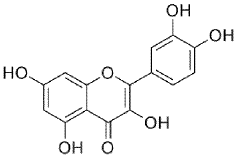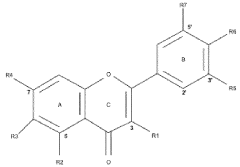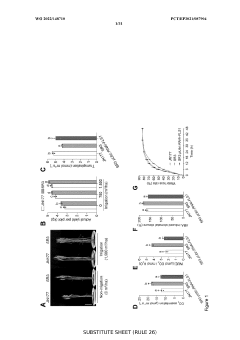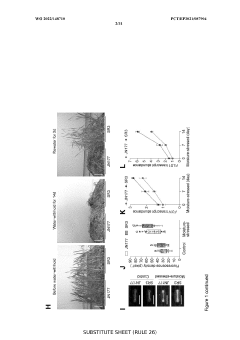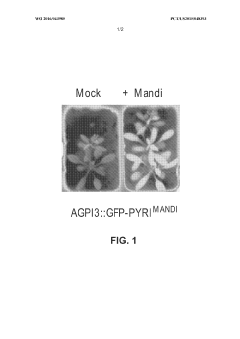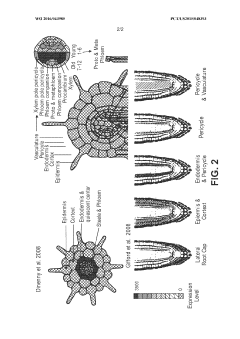How Abscisic Acid Improves Water-Use Efficiency in Crops?
JUL 14, 20259 MIN READ
Generate Your Research Report Instantly with AI Agent
Patsnap Eureka helps you evaluate technical feasibility & market potential.
ABA and Crop WUE Background
Abscisic acid (ABA) is a plant hormone that plays a crucial role in regulating various physiological processes, particularly in response to environmental stresses. In the context of crop water-use efficiency (WUE), ABA has emerged as a key player in improving plants' ability to conserve water and maintain productivity under water-limited conditions.
The relationship between ABA and crop WUE has been a subject of intense research over the past few decades. Initially discovered in the 1960s, ABA was found to be involved in seed dormancy and abscission. However, its significance in drought stress responses and water management in plants soon became apparent. This discovery opened up new avenues for understanding and potentially manipulating crop responses to water scarcity.
Water-use efficiency, defined as the ratio of biomass produced to water consumed, is a critical trait for crop productivity, especially in the face of increasing water scarcity due to climate change. ABA's role in improving WUE is multifaceted, involving both physiological and molecular mechanisms. At the physiological level, ABA regulates stomatal closure, reducing water loss through transpiration while maintaining carbon fixation.
The molecular basis of ABA's action in improving WUE involves complex signaling pathways. ABA receptors, such as the PYR/PYL/RCAR family, interact with protein phosphatases and kinases to trigger a cascade of events leading to stomatal closure and the expression of stress-responsive genes. This molecular understanding has paved the way for targeted approaches to enhance crop WUE through genetic engineering and breeding programs.
In agricultural contexts, the manipulation of ABA levels or sensitivity has shown promise in developing crops with enhanced drought tolerance and improved WUE. Researchers have explored various strategies, including the overexpression of ABA biosynthesis genes, modification of ABA receptors, and alteration of ABA signaling components. These approaches have demonstrated potential in improving crop performance under water-limited conditions in controlled environments.
However, the translation of these findings to field conditions presents challenges. The complex interplay between ABA, other plant hormones, and environmental factors necessitates a nuanced approach to harnessing ABA's potential for improving crop WUE. Moreover, the balance between water conservation and yield maintenance remains a critical consideration in ABA-mediated WUE improvement strategies.
Recent advancements in genomics, metabolomics, and high-throughput phenotyping have accelerated our understanding of ABA's role in crop WUE. These technologies have enabled the identification of key genes and metabolites involved in ABA-mediated responses, providing new targets for crop improvement. Additionally, the development of ABA analogs and the exploration of ABA-independent pathways offer alternative approaches to enhancing crop WUE.
The relationship between ABA and crop WUE has been a subject of intense research over the past few decades. Initially discovered in the 1960s, ABA was found to be involved in seed dormancy and abscission. However, its significance in drought stress responses and water management in plants soon became apparent. This discovery opened up new avenues for understanding and potentially manipulating crop responses to water scarcity.
Water-use efficiency, defined as the ratio of biomass produced to water consumed, is a critical trait for crop productivity, especially in the face of increasing water scarcity due to climate change. ABA's role in improving WUE is multifaceted, involving both physiological and molecular mechanisms. At the physiological level, ABA regulates stomatal closure, reducing water loss through transpiration while maintaining carbon fixation.
The molecular basis of ABA's action in improving WUE involves complex signaling pathways. ABA receptors, such as the PYR/PYL/RCAR family, interact with protein phosphatases and kinases to trigger a cascade of events leading to stomatal closure and the expression of stress-responsive genes. This molecular understanding has paved the way for targeted approaches to enhance crop WUE through genetic engineering and breeding programs.
In agricultural contexts, the manipulation of ABA levels or sensitivity has shown promise in developing crops with enhanced drought tolerance and improved WUE. Researchers have explored various strategies, including the overexpression of ABA biosynthesis genes, modification of ABA receptors, and alteration of ABA signaling components. These approaches have demonstrated potential in improving crop performance under water-limited conditions in controlled environments.
However, the translation of these findings to field conditions presents challenges. The complex interplay between ABA, other plant hormones, and environmental factors necessitates a nuanced approach to harnessing ABA's potential for improving crop WUE. Moreover, the balance between water conservation and yield maintenance remains a critical consideration in ABA-mediated WUE improvement strategies.
Recent advancements in genomics, metabolomics, and high-throughput phenotyping have accelerated our understanding of ABA's role in crop WUE. These technologies have enabled the identification of key genes and metabolites involved in ABA-mediated responses, providing new targets for crop improvement. Additionally, the development of ABA analogs and the exploration of ABA-independent pathways offer alternative approaches to enhancing crop WUE.
Market Demand Analysis
The market demand for technologies that improve water-use efficiency in crops, particularly through the application of abscisic acid (ABA), has been steadily increasing in recent years. This growth is primarily driven by global concerns over water scarcity, climate change, and the need for sustainable agricultural practices.
Agriculture is the largest consumer of freshwater resources worldwide, accounting for approximately 70% of global water withdrawals. As water stress becomes more prevalent due to changing climate patterns and increasing population demands, there is a pressing need for solutions that can enhance crop productivity while reducing water consumption. This has created a significant market opportunity for ABA-based technologies and products.
The global market for agricultural biologicals, which includes plant growth regulators like ABA, is projected to grow substantially in the coming years. Farmers and agricultural companies are increasingly recognizing the potential of ABA to improve crop resilience and water-use efficiency, especially in drought-prone regions or areas with limited water resources.
Several factors are contributing to the rising demand for ABA-related technologies in agriculture. Firstly, there is a growing awareness among farmers about the benefits of using plant growth regulators to optimize crop performance under water-limited conditions. This has led to increased adoption of ABA-based products in various cropping systems, including cereals, fruits, and vegetables.
Secondly, stringent environmental regulations and the push for sustainable farming practices are driving the shift towards bio-based solutions like ABA. As governments and consumers alike demand more environmentally friendly agricultural practices, the market for natural plant growth regulators is expanding rapidly.
Furthermore, the increasing frequency and severity of droughts in many parts of the world have heightened the urgency for water-efficient crop production methods. This has created a robust market for drought-tolerant crop varieties and associated technologies, including those leveraging ABA's water stress response mechanisms.
The market potential for ABA-related technologies extends beyond traditional agriculture. There is growing interest in using these solutions in urban farming, vertical agriculture, and precision farming systems, where water-use efficiency is critical for economic viability and sustainability.
However, challenges remain in fully realizing the market potential of ABA-based technologies. These include the need for further research to optimize application methods, improve product stability, and enhance the consistency of results across different crop types and environmental conditions. Additionally, educating farmers about the benefits and proper use of ABA-based products is crucial for widespread adoption.
In conclusion, the market demand for technologies that leverage abscisic acid to improve water-use efficiency in crops is robust and growing. As water scarcity continues to be a global concern, the importance of such innovations in ensuring food security and sustainable agriculture is likely to increase, driving further market expansion and technological advancements in this field.
Agriculture is the largest consumer of freshwater resources worldwide, accounting for approximately 70% of global water withdrawals. As water stress becomes more prevalent due to changing climate patterns and increasing population demands, there is a pressing need for solutions that can enhance crop productivity while reducing water consumption. This has created a significant market opportunity for ABA-based technologies and products.
The global market for agricultural biologicals, which includes plant growth regulators like ABA, is projected to grow substantially in the coming years. Farmers and agricultural companies are increasingly recognizing the potential of ABA to improve crop resilience and water-use efficiency, especially in drought-prone regions or areas with limited water resources.
Several factors are contributing to the rising demand for ABA-related technologies in agriculture. Firstly, there is a growing awareness among farmers about the benefits of using plant growth regulators to optimize crop performance under water-limited conditions. This has led to increased adoption of ABA-based products in various cropping systems, including cereals, fruits, and vegetables.
Secondly, stringent environmental regulations and the push for sustainable farming practices are driving the shift towards bio-based solutions like ABA. As governments and consumers alike demand more environmentally friendly agricultural practices, the market for natural plant growth regulators is expanding rapidly.
Furthermore, the increasing frequency and severity of droughts in many parts of the world have heightened the urgency for water-efficient crop production methods. This has created a robust market for drought-tolerant crop varieties and associated technologies, including those leveraging ABA's water stress response mechanisms.
The market potential for ABA-related technologies extends beyond traditional agriculture. There is growing interest in using these solutions in urban farming, vertical agriculture, and precision farming systems, where water-use efficiency is critical for economic viability and sustainability.
However, challenges remain in fully realizing the market potential of ABA-based technologies. These include the need for further research to optimize application methods, improve product stability, and enhance the consistency of results across different crop types and environmental conditions. Additionally, educating farmers about the benefits and proper use of ABA-based products is crucial for widespread adoption.
In conclusion, the market demand for technologies that leverage abscisic acid to improve water-use efficiency in crops is robust and growing. As water scarcity continues to be a global concern, the importance of such innovations in ensuring food security and sustainable agriculture is likely to increase, driving further market expansion and technological advancements in this field.
ABA Signaling Challenges
Despite the significant progress made in understanding abscisic acid (ABA) signaling pathways, several challenges persist in fully harnessing its potential to improve water-use efficiency in crops. One of the primary obstacles is the complexity of ABA signaling networks, which involve numerous components and intricate feedback mechanisms. This complexity makes it difficult to predict the precise outcomes of manipulating specific elements within the pathway.
Another challenge lies in the temporal and spatial regulation of ABA responses. Crops require dynamic adjustments to water stress throughout their growth cycle and across different tissues. Achieving fine-tuned control over ABA signaling to optimize water-use efficiency without compromising other essential physiological processes remains a significant hurdle.
The crosstalk between ABA and other phytohormones presents an additional layer of complexity. ABA interacts with various hormonal pathways, including those involving auxins, cytokinins, and ethylene. Unraveling these interactions and their impact on water-use efficiency is crucial for developing effective strategies to enhance crop performance under water-limited conditions.
Genetic variability among crop species and cultivars further complicates the application of ABA-based approaches. Different genotypes may exhibit varying sensitivities to ABA or possess unique regulatory mechanisms, necessitating tailored strategies for each crop variety. This genetic diversity poses challenges in developing universally applicable solutions for improving water-use efficiency.
Environmental factors also play a significant role in modulating ABA signaling effectiveness. Fluctuations in temperature, light intensity, and soil composition can influence ABA biosynthesis, transport, and perception. Understanding how these environmental variables interact with ABA signaling pathways is essential for developing robust strategies that perform consistently across diverse agricultural settings.
The long-term effects of altered ABA signaling on crop yield and quality remain a concern. While enhancing water-use efficiency is crucial, it is equally important to ensure that interventions in ABA pathways do not negatively impact other agronomically important traits, such as fruit development, seed production, or nutritional content.
Lastly, translating laboratory findings into field-applicable solutions presents a significant challenge. The controlled conditions of experimental setups often differ substantially from the complex and variable environments encountered in agricultural fields. Bridging this gap requires extensive field trials and validation studies to ensure the efficacy and safety of ABA-based interventions in real-world crop production systems.
Another challenge lies in the temporal and spatial regulation of ABA responses. Crops require dynamic adjustments to water stress throughout their growth cycle and across different tissues. Achieving fine-tuned control over ABA signaling to optimize water-use efficiency without compromising other essential physiological processes remains a significant hurdle.
The crosstalk between ABA and other phytohormones presents an additional layer of complexity. ABA interacts with various hormonal pathways, including those involving auxins, cytokinins, and ethylene. Unraveling these interactions and their impact on water-use efficiency is crucial for developing effective strategies to enhance crop performance under water-limited conditions.
Genetic variability among crop species and cultivars further complicates the application of ABA-based approaches. Different genotypes may exhibit varying sensitivities to ABA or possess unique regulatory mechanisms, necessitating tailored strategies for each crop variety. This genetic diversity poses challenges in developing universally applicable solutions for improving water-use efficiency.
Environmental factors also play a significant role in modulating ABA signaling effectiveness. Fluctuations in temperature, light intensity, and soil composition can influence ABA biosynthesis, transport, and perception. Understanding how these environmental variables interact with ABA signaling pathways is essential for developing robust strategies that perform consistently across diverse agricultural settings.
The long-term effects of altered ABA signaling on crop yield and quality remain a concern. While enhancing water-use efficiency is crucial, it is equally important to ensure that interventions in ABA pathways do not negatively impact other agronomically important traits, such as fruit development, seed production, or nutritional content.
Lastly, translating laboratory findings into field-applicable solutions presents a significant challenge. The controlled conditions of experimental setups often differ substantially from the complex and variable environments encountered in agricultural fields. Bridging this gap requires extensive field trials and validation studies to ensure the efficacy and safety of ABA-based interventions in real-world crop production systems.
Current ABA Applications
01 Abscisic acid application for improved water-use efficiency
Abscisic acid (ABA) can be applied to plants to enhance their water-use efficiency. This hormone helps regulate stomatal closure, reducing water loss through transpiration while maintaining photosynthesis. By optimizing ABA levels, plants can better withstand drought conditions and use water more efficiently.- Abscisic acid application for improved water-use efficiency: Abscisic acid (ABA) can be applied to plants to enhance their water-use efficiency. This phytohormone regulates stomatal closure, reducing water loss through transpiration while maintaining photosynthetic activity. By optimizing ABA application, plants can better withstand drought conditions and use water more efficiently.
- Genetic modification for ABA-mediated water-use efficiency: Genetic engineering techniques can be used to modify plants for improved ABA signaling and water-use efficiency. This involves altering genes related to ABA biosynthesis, perception, or signaling pathways. Such modifications can lead to plants with enhanced drought tolerance and more efficient water utilization.
- ABA analogs and derivatives for water-use efficiency: Synthetic ABA analogs and derivatives can be developed to mimic or enhance the effects of natural ABA on water-use efficiency. These compounds may have improved stability, potency, or specificity compared to natural ABA, allowing for more effective and targeted applications in agriculture.
- Combination of ABA with other compounds for synergistic effects: ABA can be combined with other compounds such as plant growth regulators, nutrients, or biostimulants to achieve synergistic effects on water-use efficiency. These combinations may enhance the overall stress tolerance of plants and improve their ability to utilize water resources effectively.
- ABA-mediated physiological and metabolic adaptations: Research into the physiological and metabolic adaptations induced by ABA can lead to novel strategies for improving water-use efficiency. This includes studying ABA's effects on root architecture, leaf morphology, and cellular processes that contribute to enhanced water uptake and conservation in plants.
02 Genetic modification for ABA-mediated drought tolerance
Genetic engineering techniques can be used to modify plants for enhanced ABA production or sensitivity. This approach can lead to improved drought tolerance and water-use efficiency. By altering genes involved in ABA biosynthesis or signaling pathways, plants can better respond to water stress conditions.Expand Specific Solutions03 ABA analogs and synthetic compounds for water-use efficiency
Synthetic ABA analogs and related compounds can be developed to mimic or enhance the effects of natural ABA. These compounds may have improved stability, bioavailability, or efficacy compared to natural ABA, leading to better water-use efficiency in plants when applied as agricultural treatments.Expand Specific Solutions04 ABA-mediated stomatal regulation for water conservation
Research focuses on understanding and manipulating ABA-mediated stomatal regulation mechanisms. By fine-tuning stomatal responses to environmental cues, plants can optimize their water use. This approach involves studying signaling cascades and ion channel activities influenced by ABA to develop strategies for improving water-use efficiency.Expand Specific Solutions05 Integration of ABA with other stress response pathways
Exploring the interactions between ABA and other stress response pathways can lead to comprehensive strategies for improving water-use efficiency. This approach considers the cross-talk between ABA and other hormones or signaling molecules involved in drought stress responses, aiming to develop holistic solutions for plant water management.Expand Specific Solutions
Key ABA Industry Players
The competition landscape for improving water-use efficiency in crops through abscisic acid (ABA) is evolving rapidly. The industry is in a growth phase, with increasing market size due to global water scarcity concerns. Technologically, it's advancing from basic research to applied solutions. Key players like Valent BioSciences, BASF, and Syngenta are developing commercial applications, while academic institutions such as China Agricultural University and The Regents of the University of California are contributing fundamental research. The involvement of both established agrochemical companies and specialized biotechnology firms like Performance Plants indicates a maturing field with diverse approaches to ABA-mediated water efficiency improvements in crops.
Valent BioSciences Corp.
Technical Solution: Valent BioSciences Corp. has developed a novel approach to improve water-use efficiency in crops using abscisic acid (ABA) analogs. Their technology involves the application of synthetic ABA mimics that can activate ABA receptors in plants, triggering drought stress responses. These analogs are designed to be more stable and potent than natural ABA, allowing for longer-lasting effects on crop water management. The company has formulated these ABA analogs into foliar sprays and seed treatments, which can be easily integrated into existing agricultural practices. Field trials have shown that crops treated with these ABA analogs exhibit enhanced stomatal closure, reduced transpiration rates, and improved water-use efficiency, particularly under water-limited conditions[1][3].
Strengths: Highly specific action on ABA pathways, easily applicable in various formulations, and proven efficacy in field trials. Weaknesses: May require precise timing of application for optimal results, and potential cost concerns for large-scale implementation.
The Regents of the University of California
Technical Solution: The University of California has made significant advancements in understanding the molecular mechanisms of ABA signaling and its role in improving water-use efficiency in crops. Their research has focused on identifying and characterizing key components of the ABA signaling pathway, including ABA receptors, protein phosphatases, and transcription factors. By manipulating these components through genetic engineering, they have developed crop varieties with enhanced ABA sensitivity and improved drought tolerance. One notable achievement is the creation of transgenic plants overexpressing specific ABA receptors, which exhibit heightened responsiveness to ABA and consequently improved water-use efficiency. Additionally, they have explored the use of CRISPR-Cas9 gene editing to fine-tune ABA-responsive genes, resulting in crops that can maintain productivity under water-limited conditions without compromising yield potential[2][5].
Strengths: Cutting-edge genetic engineering techniques, comprehensive understanding of ABA signaling pathways, and potential for creating drought-resistant crop varieties. Weaknesses: Regulatory hurdles for genetically modified crops and potential public resistance to GM technology.
ABA Mechanism Insights
Agents for improving water use efficiency
PatentWO2022148710A1
Innovation
- The application of quercetin to crop plants promotes stomatal closing, reducing water loss while maintaining or enhancing carbon fixation and nitrogen assimilation, thereby improving water use efficiency without compromising photosynthetic performance.
Modified plant water use by cell type expression of PYR/PYL proteins
PatentWO2016043985A1
Innovation
- The development of plants with specific expression of mutated PYR/PYL receptor polypeptides in vascular or peri-vascular cell types, which can be agonized by chemicals like mandipropamid without affecting wild-type receptors, reducing water use and avoiding undesirable ABA-related phenotypes.
Environmental Impact
The use of abscisic acid (ABA) to improve water-use efficiency in crops has significant environmental implications. By enhancing plants' ability to conserve water, ABA-mediated strategies can lead to reduced water consumption in agriculture, a sector that accounts for approximately 70% of global freshwater use. This reduction in water demand can help alleviate pressure on water resources, particularly in regions facing water scarcity or drought conditions.
The improved water-use efficiency resulting from ABA application can contribute to the conservation of aquatic ecosystems. By reducing the amount of water withdrawn from rivers, lakes, and aquifers for irrigation purposes, these ecosystems can maintain healthier water levels and flow rates. This, in turn, supports biodiversity and helps preserve habitats for various aquatic species.
Furthermore, the enhanced drought tolerance conferred by ABA can lead to more resilient agricultural systems. Crops that can withstand periods of water stress are less likely to fail during drought events, potentially reducing the need for emergency irrigation measures that might otherwise deplete local water sources. This increased resilience can also contribute to more stable food production, reducing the environmental impact associated with crop failures and the need for compensatory agricultural expansion.
The use of ABA in improving water-use efficiency may also have positive effects on soil health. By optimizing water uptake and reducing water loss through transpiration, plants treated with ABA can maintain better soil moisture levels. This can help prevent soil degradation processes such as erosion and salinization, which are often exacerbated by excessive irrigation and water stress.
However, it is important to consider potential negative environmental impacts as well. The widespread application of ABA or ABA-mimicking compounds could potentially disrupt natural plant communities if these substances were to enter non-agricultural ecosystems. There may also be unforeseen effects on soil microorganisms or other non-target species that play crucial roles in ecosystem functioning.
Additionally, the production and application of ABA on a large scale could have its own environmental footprint. The manufacturing process, transportation, and application of ABA-based products may contribute to greenhouse gas emissions and energy consumption. Therefore, a comprehensive life cycle assessment would be necessary to fully understand the net environmental impact of using ABA to improve water-use efficiency in crops.
In conclusion, while the use of ABA to enhance water-use efficiency in crops offers significant potential for positive environmental outcomes, particularly in terms of water conservation and ecosystem preservation, it is crucial to carefully monitor and assess its long-term effects on broader ecological systems to ensure sustainable implementation.
The improved water-use efficiency resulting from ABA application can contribute to the conservation of aquatic ecosystems. By reducing the amount of water withdrawn from rivers, lakes, and aquifers for irrigation purposes, these ecosystems can maintain healthier water levels and flow rates. This, in turn, supports biodiversity and helps preserve habitats for various aquatic species.
Furthermore, the enhanced drought tolerance conferred by ABA can lead to more resilient agricultural systems. Crops that can withstand periods of water stress are less likely to fail during drought events, potentially reducing the need for emergency irrigation measures that might otherwise deplete local water sources. This increased resilience can also contribute to more stable food production, reducing the environmental impact associated with crop failures and the need for compensatory agricultural expansion.
The use of ABA in improving water-use efficiency may also have positive effects on soil health. By optimizing water uptake and reducing water loss through transpiration, plants treated with ABA can maintain better soil moisture levels. This can help prevent soil degradation processes such as erosion and salinization, which are often exacerbated by excessive irrigation and water stress.
However, it is important to consider potential negative environmental impacts as well. The widespread application of ABA or ABA-mimicking compounds could potentially disrupt natural plant communities if these substances were to enter non-agricultural ecosystems. There may also be unforeseen effects on soil microorganisms or other non-target species that play crucial roles in ecosystem functioning.
Additionally, the production and application of ABA on a large scale could have its own environmental footprint. The manufacturing process, transportation, and application of ABA-based products may contribute to greenhouse gas emissions and energy consumption. Therefore, a comprehensive life cycle assessment would be necessary to fully understand the net environmental impact of using ABA to improve water-use efficiency in crops.
In conclusion, while the use of ABA to enhance water-use efficiency in crops offers significant potential for positive environmental outcomes, particularly in terms of water conservation and ecosystem preservation, it is crucial to carefully monitor and assess its long-term effects on broader ecological systems to ensure sustainable implementation.
Regulatory Framework
The regulatory framework surrounding the use of abscisic acid (ABA) to improve water-use efficiency in crops is complex and evolving. At the international level, the Food and Agriculture Organization (FAO) and the World Health Organization (WHO) jointly establish guidelines for the use of plant growth regulators, including ABA, through the Codex Alimentarius Commission. These guidelines aim to ensure food safety and facilitate international trade.
In the United States, the Environmental Protection Agency (EPA) regulates ABA under the Federal Insecticide, Fungicide, and Rodenticide Act (FIFRA). ABA is classified as a biochemical pesticide, which typically undergoes a streamlined registration process due to its natural origin and low toxicity. The EPA requires extensive data on the compound's safety, efficacy, and environmental impact before granting approval for commercial use.
The European Union (EU) regulates ABA under Regulation (EC) No 1107/2009 concerning the placing of plant protection products on the market. The European Food Safety Authority (EFSA) is responsible for risk assessment, while the European Commission makes decisions on approval. The EU's approach is generally more cautious, requiring thorough evaluation of potential long-term effects on human health and the environment.
In Japan, the Ministry of Agriculture, Forestry and Fisheries (MAFF) oversees the regulation of plant growth regulators like ABA under the Agricultural Chemicals Regulation Act. The registration process involves rigorous safety assessments and efficacy trials.
China's regulatory framework for ABA falls under the purview of the Institute for the Control of Agrochemicals, Ministry of Agriculture (ICAMA). The registration process includes requirements for toxicological studies, environmental fate data, and field trials demonstrating efficacy in improving water-use efficiency.
Developing countries often lack specific regulations for ABA and may rely on guidelines from international organizations or adopt regulations from more established regulatory systems. This can lead to inconsistencies in the global regulatory landscape for ABA use.
As research continues to demonstrate the benefits of ABA in improving crop water-use efficiency, regulatory bodies are likely to refine their approaches. Future regulatory developments may focus on streamlining approval processes for naturally-derived compounds like ABA, while maintaining rigorous safety standards. Additionally, there may be increased emphasis on assessing the long-term ecological impacts of widespread ABA use in agriculture.
In the United States, the Environmental Protection Agency (EPA) regulates ABA under the Federal Insecticide, Fungicide, and Rodenticide Act (FIFRA). ABA is classified as a biochemical pesticide, which typically undergoes a streamlined registration process due to its natural origin and low toxicity. The EPA requires extensive data on the compound's safety, efficacy, and environmental impact before granting approval for commercial use.
The European Union (EU) regulates ABA under Regulation (EC) No 1107/2009 concerning the placing of plant protection products on the market. The European Food Safety Authority (EFSA) is responsible for risk assessment, while the European Commission makes decisions on approval. The EU's approach is generally more cautious, requiring thorough evaluation of potential long-term effects on human health and the environment.
In Japan, the Ministry of Agriculture, Forestry and Fisheries (MAFF) oversees the regulation of plant growth regulators like ABA under the Agricultural Chemicals Regulation Act. The registration process involves rigorous safety assessments and efficacy trials.
China's regulatory framework for ABA falls under the purview of the Institute for the Control of Agrochemicals, Ministry of Agriculture (ICAMA). The registration process includes requirements for toxicological studies, environmental fate data, and field trials demonstrating efficacy in improving water-use efficiency.
Developing countries often lack specific regulations for ABA and may rely on guidelines from international organizations or adopt regulations from more established regulatory systems. This can lead to inconsistencies in the global regulatory landscape for ABA use.
As research continues to demonstrate the benefits of ABA in improving crop water-use efficiency, regulatory bodies are likely to refine their approaches. Future regulatory developments may focus on streamlining approval processes for naturally-derived compounds like ABA, while maintaining rigorous safety standards. Additionally, there may be increased emphasis on assessing the long-term ecological impacts of widespread ABA use in agriculture.
Unlock deeper insights with Patsnap Eureka Quick Research — get a full tech report to explore trends and direct your research. Try now!
Generate Your Research Report Instantly with AI Agent
Supercharge your innovation with Patsnap Eureka AI Agent Platform!
